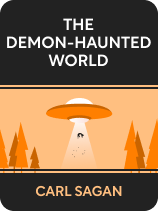

This article is an excerpt from the Shortform book guide to "The Demon-Haunted World" by Carl Sagan. Shortform has the world's best summaries and analyses of books you should be reading.
Like this article? Sign up for a free trial here .
What’s pseudoscience? Why do some people believe in astrology and angels? What harm can it cause?
Carl Sagan claims that unscientific beliefs are becoming more and more common in the modern age. In The Demon-Haunted World, he discusses pseudosciences and supernatural beliefs. He explains how they spread and why they’re dangerous, arguing that this type of belief impairs our ability to make decisions of all kinds.
Keep reading for Sagan’s take on pseudoscience and the supernatural.
The Spread of Unscientific Beliefs
Pseudoscience is an idea or system of explanation that claims to be scientifically true but is actually based on faulty premises or insufficient evidence. In other words, pseudoscience is misinformation disguised as science. Pseudosciences come in many forms. As Sagan claims, for virtually every field of science, there is a corresponding form of pseudoscience. Geology, for example, has flat-earthers. Chemistry has alchemy. Astronomy has astrology.
The supernatural, on the other hand, is something that exists outside the laws of nature. Supernatural beliefs often come in the form of religious ideologies. Both New Age spirituality and the old faith-based religions are broadly followed in modern times. Things such as demons, angels, gods, or spirits are widely accepted. Supernatural beliefs can also come in secular forms such as magic or extrasensory perception.
The differences between pseudoscience and the supernatural can be difficult to determine. The lines separating them are blurry. Astrology, for example, may fall in both categories. What they have in common is that they are unscientific. We’ll examine why pseudosciences and supernatural beliefs are so common and why they’re dangerous.
| Unscientific Beliefs Today Since Sagan published The Demon-Haunted World in 1995, unscientific beliefs continue to be widespread. The United States has the highest number of flat-earthers and climate change skeptics in the world. Sixteen percent of Americans have doubts about the roundness of the Earth and 40% don’t think there is climate change caused by human activity. Seemingly innocuous beliefs like these may be indicative of a culture of credulity, which has serious consequences, as we’ll see. Furthermore, according to a 2018 study, roughly 60% of American adults hold at least one New Age belief, which includes both supernatural and pseudoscientific ideas such as reincarnation, psychics, and astrology. For example, a third of Americans believe in reincarnation. Who’s most likely to hold unscientific beliefs? The 2018 study referenced above also examines the correlation between religious beliefs and New Age beliefs. Non-Christians are about as likely to believe in New Age beliefs as Christians, with both hovering just above 60%. Atheists, however, are much less likely to hold supernatural beliefs than either Christians or other unaffiliated religious groups, such as agnostics. Only 22% of atheists hold one or more New Age beliefs, compared to 56% of agnostics and 78% who claimed their religion is “nothing in particular.” In this data, we see a correlation between one supernatural belief and another. People who are neither religious nor spiritual are much more likely to reject New Age ideas or other supernatural beliefs. |
Why We Believe in Them
There are several psychological, social, and even practical reasons people believe in pseudosciences or supernatural phenomena.
Pseudoscience
Sagan argues that because pseudosciences mimic the processes and methods of the scientific method, they can seem like they are true, especially to people untrained in scientific or critical thinking. Furthermore, people want to believe pseudoscientific claims. People want to believe there are aliens among us, that crystals hold some form of cosmic energy that can be harnessed, and that somewhere in the depths of the ocean lies the lost city of Atlantis. Such beliefs appeal to our emotions—they can instill in us a sense of wonder, a departure from the mundanity of our everyday lives.
Supernatural
A key difference between pseudoscience and the supernatural, according to Sagan, is that while pseudosciences usually rely on faulty or misleading evidence, supernatural beliefs usually rely on the absence of evidence. It is impossible to disprove that demons, spirits, or gods exist because they exist outside the natural world.
Like pseudoscience, belief in the supernatural is largely driven by our desire to believe in it. Supernatural beliefs assuage our negative emotions and help us cope with the realities of life. Belief in a psychic’s ability to speak with the dead helps us cope with our grief, for example. Belief in the afterlife alleviates our fear of death. Supernatural beliefs can also give meaning and purpose to our lives. They can help explain the unexplainable, filling in the gaps of our incomplete understanding of the world.
| How Biases Shape Our Beliefs Since the book’s publication, scientists have gained a better understanding of the powerful cognitive biases that cause us to cling to unscientific beliefs. Sunk cost fallacy: If people have believed in something for a long time, if they’ve invested a lot of time and effort into it, they are more likely to defend this belief in an attempt to justify previous decisions based on that belief. It can be hard to completely abandon astrology if you’ve spent hundreds of hours reading horoscopes and researching celestial patterns. Confirmation bias: This is the tendency people have to latch on to evidence that supports their beliefs and reject evidence that contradicts them. In many ways, our beliefs shape the way we see the world instead of the other way around. Clustering illusion: Our brains try to find patterns. It helps us make decisions and create order out of randomness. Sometimes, though, this pattern-seeking tendency can lead us astray, creating meaning out of meaningless data or reinforcing beliefs with faulty evidence. Dunning-Kruger effect: This is the tendency for people to overestimate their own knowledge or competency on a particular subject. The more you know, the more you may doubt your own expertise. Conversely, the less you know, the less you doubt your expertise. This results in people with little knowledge having more confidence in their beliefs than the experts trying to disprove them. |
Why They’re Dangerous
Sagan argues that supernatural and pseudoscientific practices and beliefs can cause considerable harm. As they become more widespread, so does our sense of credulity—our propensity to believe in things without proof. A credulous society will be less critical and less open-minded because most of us will simply believe what we want to believe. As we stray further from the field of science and become more comfortable with pseudoscience and superstition, we lessen our capacity to distinguish between fact and opinion and between what feels good and what’s true. In doing so, we impair our ability to make important decisions, both at an individual and societal level.
Historically, we’ve seen these issues materialize again and again. One particularly striking and illuminating example is the history of witch hunts in the Western world, which peaked between the 15th and 18th centuries. The witch hunts show us how susceptible we are to unfounded beliefs and how dangerous they are, as tens of thousands of people were killed without a fair or reasonable trial.
In the modern world, we face a myriad of issues with profound social implications, such as population growth, nuclear energy, addiction, mental health, and environmental issues like climate change. Science can help us address these issues. Pseudoscience and the supernatural cannot and will likely only get in the way.
| Historical Perspective: Witch Hunts and the Satanic Panic For many scientists, the witch hunts are an excellent case study of how unscientific beliefs, combined with intense fear or moral outrage, can lead to disastrous repercussions. Sagan believes we must pay attention to how things like this happened so we don’t let them happen again. Experts suggest that mass hysteria events such as the witch trials are caused by an “epidemic of fear.” When fear is drummed up, people quickly lose their sense of rationality, resulting in almost unimaginable consequences. A more recent example of mass hysteria, one not too dissimilar from the witch hunts, can be found in the “satanic panic.” Starting in America in the 1980s, the satanic panic saw hundreds of reports on the satanic or ritualistic abuse of children. These reports include cult-like behaviors such as human sacrifices, cannibalism, consumption of blood, and widespread sexual assault. Thousands were accused of such crimes, and dozens more were imprisoned for them, often with no evidence other than personal testimonies. During this time, even law enforcement became wrapped up in the hysteria, as police agencies gave seminars that warned of things like heavy metal music and the board game Dungeons and Dragons as indicators of Satanic crime. Some suggest that the satanic panic has returned, citing recent moral panics such as the conspiracy theories maintained by QAnon followers. Even today, we are clearly susceptible to the dangers of unscientific beliefs. |

———End of Preview———
Like what you just read? Read the rest of the world's best book summary and analysis of Carl Sagan's "The Demon-Haunted World" at Shortform .
Here's what you'll find in our full The Demon-Haunted World summary :
- Carl Sagan’s argument that a less scientifically-minded society is a less prosperous one
- Why you must remain critical and well-informed in an increasingly complex world
- The decline of educational standards in America and possible ways to reverse it






